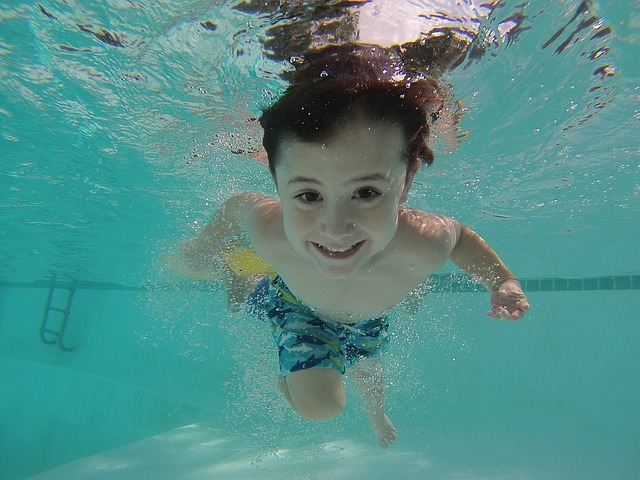Often children with developmental delays or disabilities are subjected to an early intervention (EI) program or physical or occupational therapies.
The aim of these interventions is to enhance the functional mobility of the children and to help the children perform activities of daily living more efficiently. Aquatic therapy (AT) is included in EI as a supplemental program because of its observed beneficial effects on the overall motor activity of toddlers.
What Is Aquatic Therapy?
Aquatic therapy refers to exercises performed in water for physical rehabilitation, fitness, relaxation, and other therapeutic benefits. AT instructors are trained to address the unique needs of children with physical disabilities, often incorporating neurophysiological principles.
The buoyancy of water is believed to reduce joint loading and to help in antigravity movements. The resistive properties of water strengthen the posture and the extremities. Also, water’s increased capacity for heat transfer compared to air reduces muscle tension and involuntary movements.
Researchers at the Boston University School of Public Health in Massachusetts conducted a study titled “The Effect of Aquatic Therapy on Functional Mobility of Infants and Toddlers in Early Intervention,” in which they evaluated the beneficial effects of aquatic therapy on the functional abilities of children with disabilities who were receiving early intervention. They compared their observations with the functional abilities of children who were receiving only early intervention with no aquatic therapy.
How Was the Study Conducted?
Children receiving home-based EI with a physical therapist (PT) or occupational therapist (OT) were recruited for this study. All the children had delayed functional mobility and had completed at least one EI developmental assessment before the start of the study.
The participants of the study were divided into two groups: an intervention group receiving aquatic therapy along with home-based EI and a control group receiving only home-based EI with no aquatic therapy.
The intervention group consisted of fifteen children who spent thirty minutes a week in a pool. The researchers used thirty-minute intervals because this period seemed to be enough to affect children’s functional mobility without causing excessive fatigue.
The strategies implemented during the AT were based on the goals of the child’s Individual Family Service Plan (IFSP), which is a developmental plan of care created by the parents and the EI team. The AT included activities like gait training, kneeling and squatting, balance activities on floating mats, playing with weighted toys and water currents, stepping activities using underwater benches, and standing play.
In addition, the children also received sixty-minute weekly home visits from physical therapists or occupational therapists who worked with them on the goals mentioned in their IFSP.
The control group consisted of twenty-two children who received no aquatic therapy, but they did participate in the same type of sixty-minute home visits as the intervention group. Again, the visits included activities described in the child’s IFSP.
The study continued for thirty-six weeks (nine months). The researchers believed that a nine-month study duration was long enough to positively influence the children’s functional mobility skills without burdening the parents with a long time commitment.
The functional mobility of the children was assessed using the Mullen Scales of Early Learning (MSEL). The MSEL is a comprehensive developmental assessment consisting of various parameters. The Massachusetts Department of Public Health, which oversees EI services in the state, mandates its use for developmental assessment.
Results and Conclusion
Early intervention with aquatic therapy proved to be more effective in enhancing the functional mobility of children than early intervention without aquatic therapy.
The toddlers’ functional mobility was assessed before and after the completion of the study, and then the results were compared. The mean functional mobility measure of the intervention group before the study began was 27.5, which increased to 30.6 after the completion of the study. For the control group, the mean functional mobility measure was 32.5 before the start of the study, which decreased to 28.4 after the completion of the study, indicating a gross decrease in the functional mobility of the children who did not receive aquatic therapy.
The results show that the children who received aquatic therapy in addition to home-based EI visits by physical or occupational therapists had greater functional mobility than the children who received only home-based EI services without aquatic therapy.
The parents of toddlers undergoing aquatic therapy also reported improvement in the children’s movement inside the house as well as outside. The children performed daily tasks with increased ease and engaged in activities in which children who are developing normally routinely participate.
This study suggests that EI home-visits alone may not be sufficient to promote the functional mobility of all children. Pediatric physical and occupational therapists should recognize this fact and add strategies to their development plans that will help children with disabilities cope better.

Note: This article is for informative purposes only. A medical expert should be consulted before implementing any therapy or intervention for infants and children.
Reference
McManus, Beth M., and Milton Kotelchuck. “The Effect of Aquatic Therapy on Functional Mobility of Infants and Toddlers in Early Intervention.” Pediatric Physical Therapy 19, no. 4 (2007): 275–282. Retrieved from https://insights.ovid.com/pubmed?pmid=18004194













